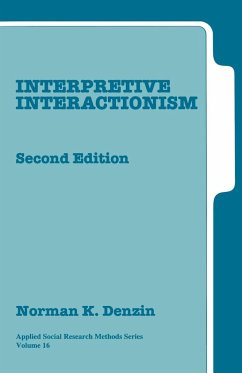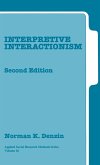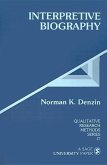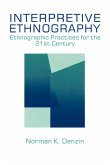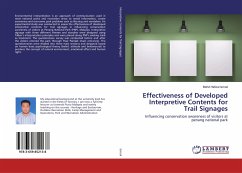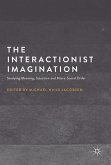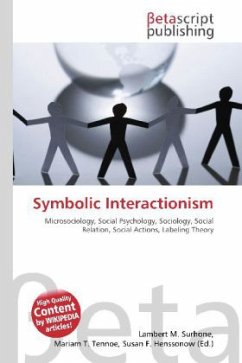Norman K. Denzin
Interpretive Interactionism
Norman K. Denzin
Interpretive Interactionism
- Broschiertes Buch
- Merkliste
- Auf die Merkliste
- Bewerten Bewerten
- Teilen
- Produkt teilen
- Produkterinnerung
- Produkterinnerung
Please update SAGE UK and SAGE INDIA addresses on imprint page.
Andere Kunden interessierten sich auch für
![Interpretive Interactionism Interpretive Interactionism]() Norman K. DenzinInterpretive Interactionism196,99 €
Norman K. DenzinInterpretive Interactionism196,99 €![Interpretive Biography Interpretive Biography]() Norman K. DenzinInterpretive Biography128,99 €
Norman K. DenzinInterpretive Biography128,99 €![Decolonizing Interpretive Research Decolonizing Interpretive Research]() Decolonizing Interpretive Research204,99 €
Decolonizing Interpretive Research204,99 €![Interpretive Ethnography Interpretive Ethnography]() Norman K. DenzinInterpretive Ethnography165,99 €
Norman K. DenzinInterpretive Ethnography165,99 €![Effectiveness of Developed Interpretive Contents for Trail Signages Effectiveness of Developed Interpretive Contents for Trail Signages]() Mohd Hafizal IsmailEffectiveness of Developed Interpretive Contents for Trail Signages51,99 €
Mohd Hafizal IsmailEffectiveness of Developed Interpretive Contents for Trail Signages51,99 €![The Interactionist Imagination The Interactionist Imagination]() The Interactionist Imagination89,99 €
The Interactionist Imagination89,99 €![Symbolic Interactionism Symbolic Interactionism]() Symbolic Interactionism24,99 €
Symbolic Interactionism24,99 €-
-
-
Please update SAGE UK and SAGE INDIA addresses on imprint page.
Hinweis: Dieser Artikel kann nur an eine deutsche Lieferadresse ausgeliefert werden.
Hinweis: Dieser Artikel kann nur an eine deutsche Lieferadresse ausgeliefert werden.
Produktdetails
- Produktdetails
- Verlag: Sage Publications
- Seitenzahl: 204
- Erscheinungstermin: 1. Oktober 2001
- Englisch
- Abmessung: 216mm x 140mm x 12mm
- Gewicht: 295g
- ISBN-13: 9780761915140
- ISBN-10: 0761915141
- Artikelnr.: 21193028
- Herstellerkennzeichnung
- Libri GmbH
- Europaallee 1
- 36244 Bad Hersfeld
- gpsr@libri.de
- Verlag: Sage Publications
- Seitenzahl: 204
- Erscheinungstermin: 1. Oktober 2001
- Englisch
- Abmessung: 216mm x 140mm x 12mm
- Gewicht: 295g
- ISBN-13: 9780761915140
- ISBN-10: 0761915141
- Artikelnr.: 21193028
- Herstellerkennzeichnung
- Libri GmbH
- Europaallee 1
- 36244 Bad Hersfeld
- gpsr@libri.de
Norman K. Denzin was Distinguished Emeritus Professor of Communications, College of Communications Scholar, and Research Professor of Communications, Sociology, and Humanities at the University of Illinois at Urbana-Champaign, USA. One of the world's foremost authorities on qualitative research and cultural criticism, he was the author or editor of more than 30 books, including The Qualitative Manifesto; Qualitative Inquiry Under Fire; Reading Race; Interpretive Ethnography; The Cinematic Society; The Alcoholic Self; and a trilogy on the American West. He was past editor of The Sociological Quarterly, co-editor of six editions of the landmark SAGE Handbook of Qualitative Research, co-editor (with Michael D. Giardina) of 18 books on qualitative inquiry, co-editor (with Yvonna S. Lincoln and Michael D. Giardina) of the methods journal Qualitative Inquiry , founding editor of Cultural Studies-Critical Methodologies and International Review of Qualitative Research, editor of four book series, and founding director of the International Congress of Qualitative Inquiry.
Preface
1. Interpretive Criteria in the Seventh Moment
Interpretive Criteria in the Seventh Moment
The Performance Turn
Experiences and Performances
Performing Montana
Conclusions
2. The Interpretive Point of View
Performing Racial Memories
Personal Biography
The Interpretive Heritage
Opening Up the World for Interpretation
What Is Interpretive Interactionism?
Interpretation and Science
History, Power, Emotion, and Knowledge
The Criteria of Interpretation
The Agenda
Conclusions
3. Securing Biographical Experience
Exemplars
Overview
Narrative¿s Moment
Selves, Narratives and Sacred Places
Interpreting and Biographical
Conclusions
4. The Interpretive Process The Steps to Interpretation
Framing the Research Question
Deconstruction
Capture
Bracketing
Construction
Contextualizing
Evaluating Interpretive Materials
Conclusions
5. Situating Interpretation
Time, History, and Mapping
Learning the Language and Its Meanings
Researcher as Newcomer and Knowing Subject
Conclusions
6. Thick Description
A Double Crisis
Thick Description as Performative Writing
Examples of Thick Description-as-Inscription
Thin Description-as-Inscription
Good and Bad Thick Description
Conclusions
7. Doing Interpretation
Exemplars of Interpretation
What Interpretation Does
Types of Interpretation and Exemplars
Performing and Representing Interpretation
Understanding
Conclusions
8. Conclusion: On Interpretive Interactionism
Interpretation
Biographical Experience
Reading and Writing Experience
Fiction and Interpretation
Interpretive Interactionism in the Postmodern Period
Glossary of Terms
References
Index
1. Interpretive Criteria in the Seventh Moment
Interpretive Criteria in the Seventh Moment
The Performance Turn
Experiences and Performances
Performing Montana
Conclusions
2. The Interpretive Point of View
Performing Racial Memories
Personal Biography
The Interpretive Heritage
Opening Up the World for Interpretation
What Is Interpretive Interactionism?
Interpretation and Science
History, Power, Emotion, and Knowledge
The Criteria of Interpretation
The Agenda
Conclusions
3. Securing Biographical Experience
Exemplars
Overview
Narrative¿s Moment
Selves, Narratives and Sacred Places
Interpreting and Biographical
Conclusions
4. The Interpretive Process The Steps to Interpretation
Framing the Research Question
Deconstruction
Capture
Bracketing
Construction
Contextualizing
Evaluating Interpretive Materials
Conclusions
5. Situating Interpretation
Time, History, and Mapping
Learning the Language and Its Meanings
Researcher as Newcomer and Knowing Subject
Conclusions
6. Thick Description
A Double Crisis
Thick Description as Performative Writing
Examples of Thick Description-as-Inscription
Thin Description-as-Inscription
Good and Bad Thick Description
Conclusions
7. Doing Interpretation
Exemplars of Interpretation
What Interpretation Does
Types of Interpretation and Exemplars
Performing and Representing Interpretation
Understanding
Conclusions
8. Conclusion: On Interpretive Interactionism
Interpretation
Biographical Experience
Reading and Writing Experience
Fiction and Interpretation
Interpretive Interactionism in the Postmodern Period
Glossary of Terms
References
Index
Preface
1. Interpretive Criteria in the Seventh Moment
Interpretive Criteria in the Seventh Moment
The Performance Turn
Experiences and Performances
Performing Montana
Conclusions
2. The Interpretive Point of View
Performing Racial Memories
Personal Biography
The Interpretive Heritage
Opening Up the World for Interpretation
What Is Interpretive Interactionism?
Interpretation and Science
History, Power, Emotion, and Knowledge
The Criteria of Interpretation
The Agenda
Conclusions
3. Securing Biographical Experience
Exemplars
Overview
Narrative¿s Moment
Selves, Narratives and Sacred Places
Interpreting and Biographical
Conclusions
4. The Interpretive Process The Steps to Interpretation
Framing the Research Question
Deconstruction
Capture
Bracketing
Construction
Contextualizing
Evaluating Interpretive Materials
Conclusions
5. Situating Interpretation
Time, History, and Mapping
Learning the Language and Its Meanings
Researcher as Newcomer and Knowing Subject
Conclusions
6. Thick Description
A Double Crisis
Thick Description as Performative Writing
Examples of Thick Description-as-Inscription
Thin Description-as-Inscription
Good and Bad Thick Description
Conclusions
7. Doing Interpretation
Exemplars of Interpretation
What Interpretation Does
Types of Interpretation and Exemplars
Performing and Representing Interpretation
Understanding
Conclusions
8. Conclusion: On Interpretive Interactionism
Interpretation
Biographical Experience
Reading and Writing Experience
Fiction and Interpretation
Interpretive Interactionism in the Postmodern Period
Glossary of Terms
References
Index
1. Interpretive Criteria in the Seventh Moment
Interpretive Criteria in the Seventh Moment
The Performance Turn
Experiences and Performances
Performing Montana
Conclusions
2. The Interpretive Point of View
Performing Racial Memories
Personal Biography
The Interpretive Heritage
Opening Up the World for Interpretation
What Is Interpretive Interactionism?
Interpretation and Science
History, Power, Emotion, and Knowledge
The Criteria of Interpretation
The Agenda
Conclusions
3. Securing Biographical Experience
Exemplars
Overview
Narrative¿s Moment
Selves, Narratives and Sacred Places
Interpreting and Biographical
Conclusions
4. The Interpretive Process The Steps to Interpretation
Framing the Research Question
Deconstruction
Capture
Bracketing
Construction
Contextualizing
Evaluating Interpretive Materials
Conclusions
5. Situating Interpretation
Time, History, and Mapping
Learning the Language and Its Meanings
Researcher as Newcomer and Knowing Subject
Conclusions
6. Thick Description
A Double Crisis
Thick Description as Performative Writing
Examples of Thick Description-as-Inscription
Thin Description-as-Inscription
Good and Bad Thick Description
Conclusions
7. Doing Interpretation
Exemplars of Interpretation
What Interpretation Does
Types of Interpretation and Exemplars
Performing and Representing Interpretation
Understanding
Conclusions
8. Conclusion: On Interpretive Interactionism
Interpretation
Biographical Experience
Reading and Writing Experience
Fiction and Interpretation
Interpretive Interactionism in the Postmodern Period
Glossary of Terms
References
Index

